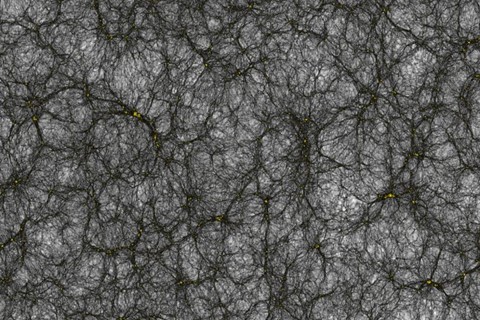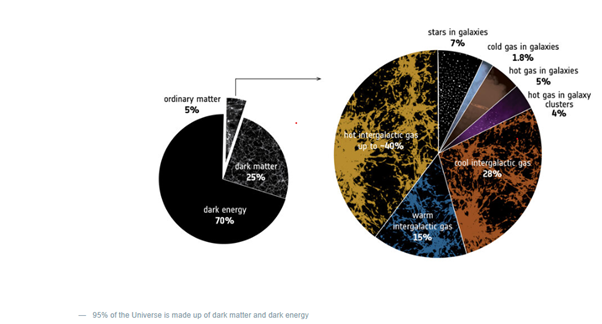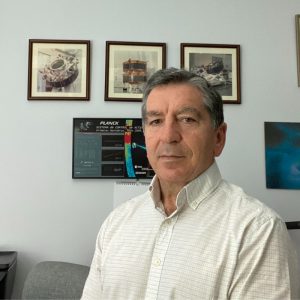
- Aerospace
Categories:
[Image: Simulation of the cosmic network of dark matter and galaxies, being the largest simulation of the universe to date © Joachim Stadel]
The universe, with its countless galaxies and celestial bodies, is a fascinating enigma that continues to captivate humanity. Among all its wonders, there exists a cosmic phenomenon that has puzzled scientists for decades: dark matter. According to ESA estimates, this accounts for approximately a quarter of the cosmos.
Hypothetically, dark matter is a form of matter that neither emits, reflects, nor interacts with electromagnetic radiation, making it invisible to traditional telescopes. Its existence was postulated to explain discrepancies between observed gravitational effects and visible matter in the universe. Although its nature remains unknown, the existence of dark matter has been deduced from its gravitational influence on the movement of stars and galaxies.
On the other hand, the evolution of the expanding universe necessitates, according to models, the existence of a form of energy whose nature is also unknown and is therefore named dark energy, constituting most of the universe and accounting for 70-75% of the universe’s composition.

The Importance of Investigating Dark Matter and Energy
Investigating dark matter and energy is of great importance for several reasons. Firstly, understanding their nature will help us comprehend the formation and evolution of galaxies. Dark matter acts as a gravitational scaffold upon which galaxies form, determining their distribution and shaping their structures. By discovering its properties, we will gain a deep insight into the mechanisms that weave the cosmic tapestry we observe today.
To delve deeper into the enigma of dark matter and energies, ESA conceived the EUCLID mission, named in honour of the mathematician Euclid of Alexandria. The mission was launched on 1st July of the past year.
The primary objective of EUCLID is to create a three-dimensional map of the distribution of dark matter in the universe and analyse the accelerated expansion of the universe, driven by dark energy. By observing the subtle effects of weak gravitational lensing—which measures the distortion of distant galaxies caused by dark matter—and the impact of baryonic acoustic oscillations, which are based on measurements of galaxy clustering, EUCLID aims to obtain a precise three-dimensional image. This will reveal the shape and evolutionary distribution of both dark matter and ordinary (or baryonic) matter in the cosmos, as well as their influence on the growth of cosmic structures over billions of years.
The EUCLID space observatory is equipped with a set of cutting-edge instruments designed for a comprehensive study of the cosmos. It is estimated that more than 1,200 professionals from over 100 laboratories across 15 countries will be involved in the analysis. The mission is expected to process over 10 petabytes of raw images, equivalent to 2,000 years of HD video. Therefore, data transmission is a key element of the mission.
In this regard, Sener has provided four critical components for the mission’s success:
- The AOCS (Attitude and Orbit Control System), with various sensor and actuator equipment at multiple points on the satellite, stabilises and controls the satellite’s and telescope’s pointing and performs the necessary manoeuvres both in orbit and attitude.
- The ADPM (Antenna Deployment and Pointing Mechanism), responsible for the deployment and movement of the high-gain antenna, enabling communication with the Earth-based operations centre for the vast amount of information generated.
- The three-degree-of-freedom mechanism (M2M), allowing the refocusing of the secondary mirror, necessary for acquiring images with sufficient quality, after the cooling of the entire optical instrument to reach a stable temperature of -173 degrees Celsius.
- The omnidirectional TTC antennas in X-band, responsible for communications during the non-scientific and safety phases of the mission.
Potential Impact of Understanding Dark Matter and Energy
EUCLID will help improve our understanding of the universe. By providing detailed observations of dark matter and energy, it will generate a wealth of data that can be used to test and refine existing models and theories. The mission’s findings will guide future research, allowing scientists to unravel the secrets of the cosmos more exhaustively.
Moreover, the technological advancements developed during these investigations will have long-term and far-reaching applications. The cutting-edge instruments and data processing techniques developed along the way will endow us with greater technological capabilities, benefiting various fields such as Earth observation, climate research, and planetary sciences.
The study of dark matter and energy represents one of the most formidable challenges in contemporary science. The EUCLID mission, as one of the most recent milestones in this field, represents a breakthrough that will undoubtedly provide us with much information to stay tuned for in the coming decades, aiding our understanding of the invisible forces that bind the cosmos.
Salvador Llorente
An aerospace engineer from the UPM (University of Madrid) and an MBA from ICADE (International Aerospace Institute of Technology), he has over 30 years of experience in the space sector, including four years spent at the European Space Agency as Head of the Dynamics and Attitude of the CLUSTER satellite constellation. Over the past 25 years at Sener, he served as the bid and project manager for the Herschel and Planck AOCS, launched in May 2009, and as project promoter and manager until 2014 for PROBA#3, where Sener led this technology demonstration space mission. From then on, he served as the proposal and later project manager for the EUCLID AOCS, launched on July 1, 2023.

 About us
About us

